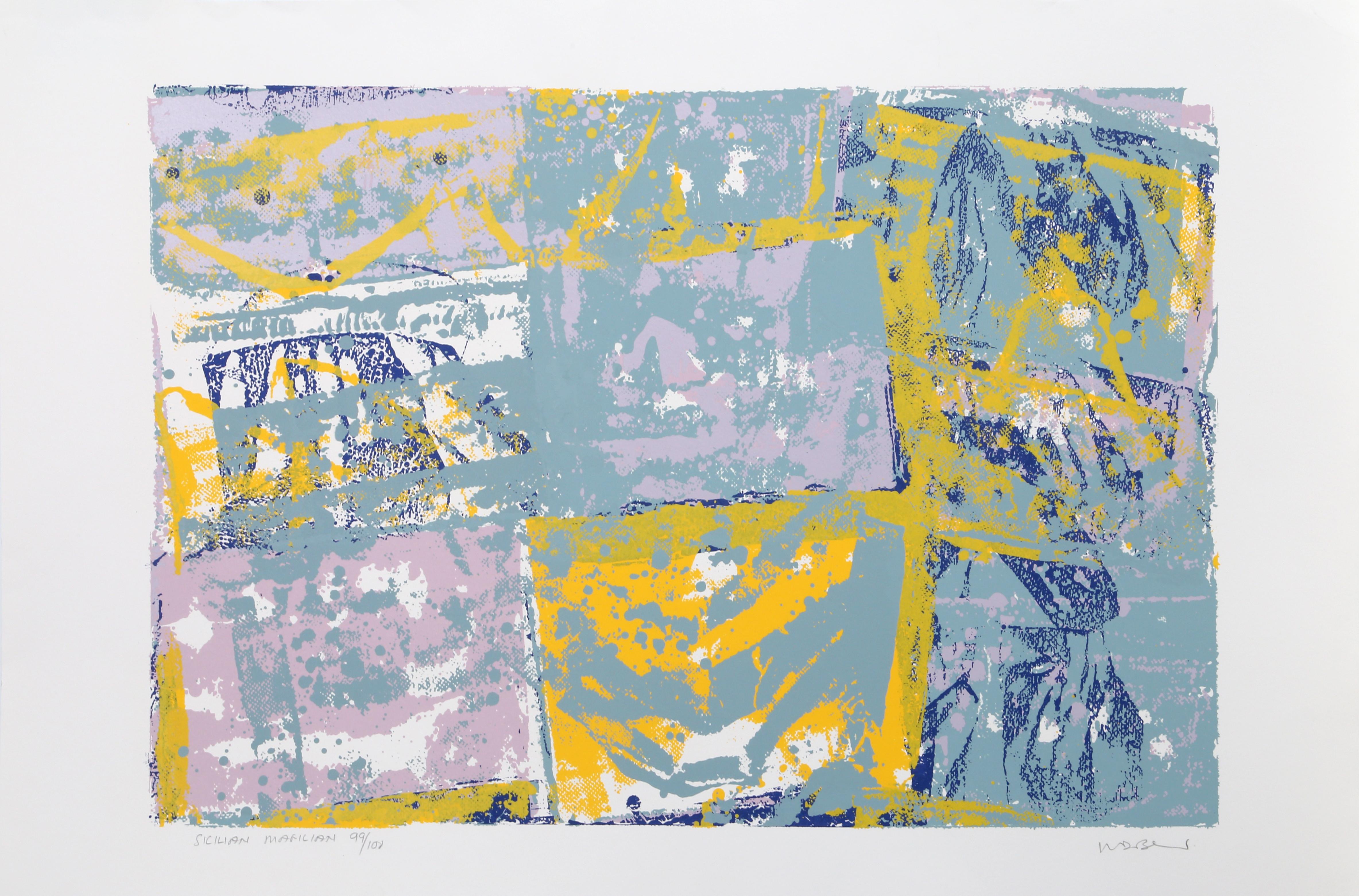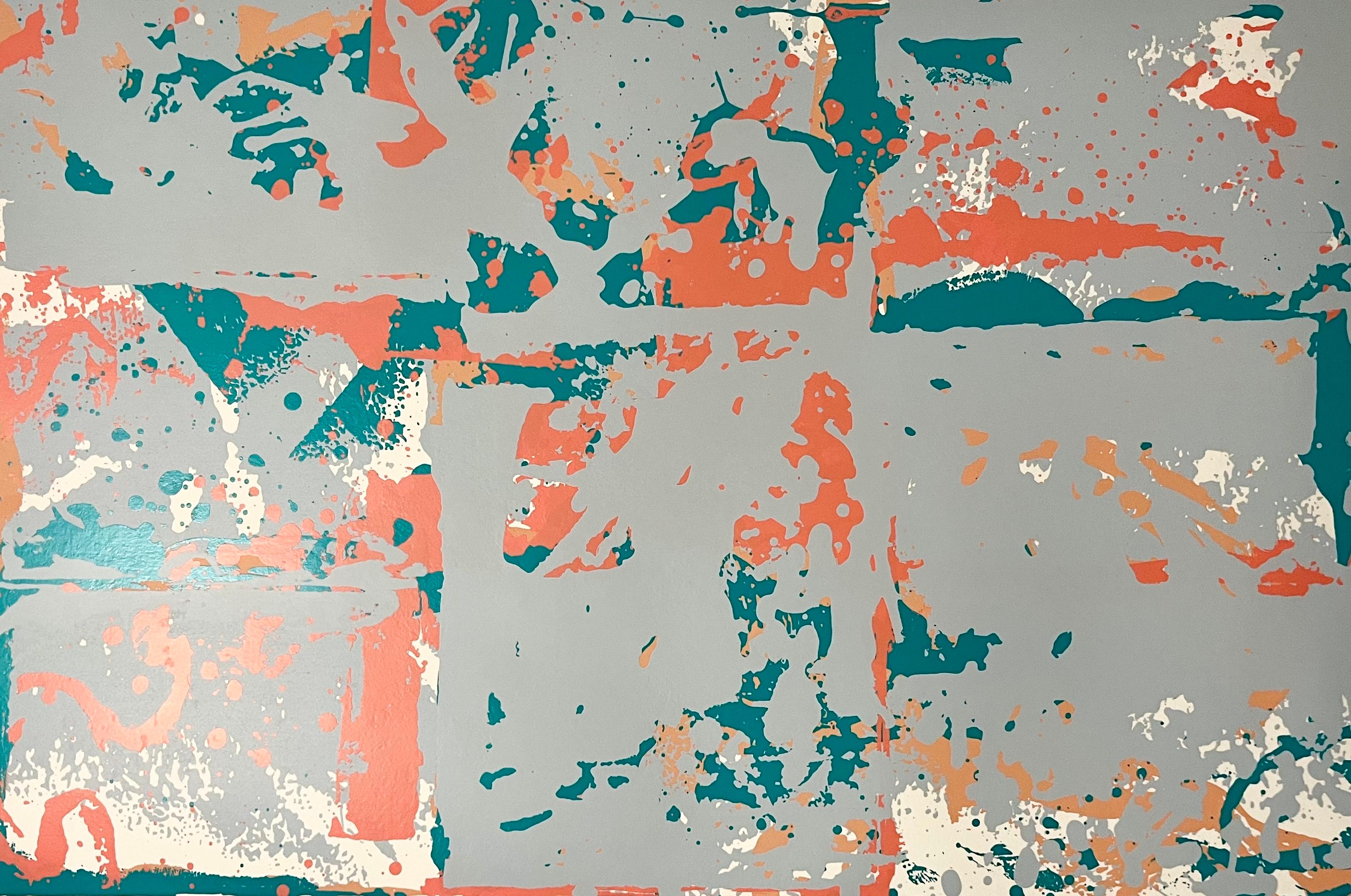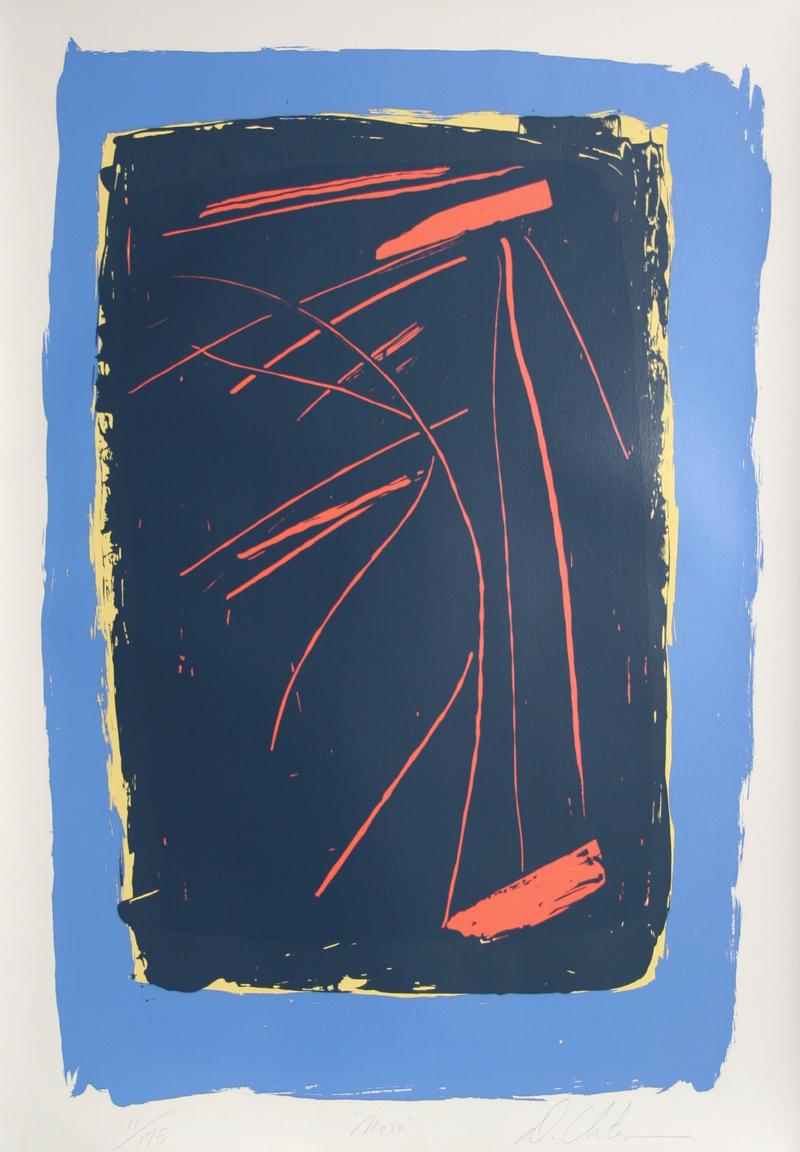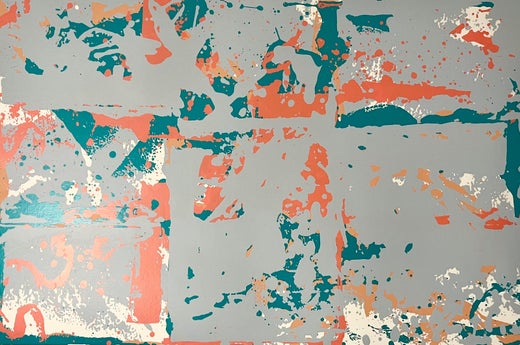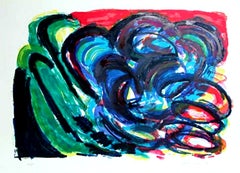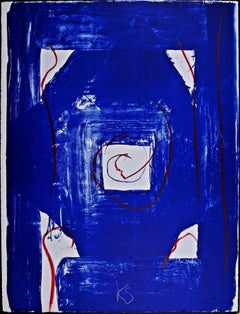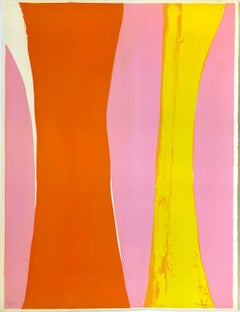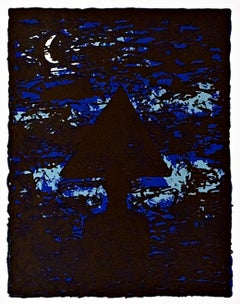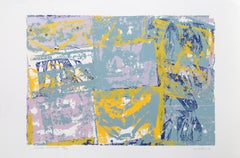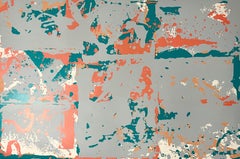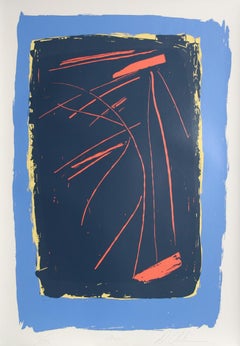Items Similar to Sicilian Magician - lt ed silkscreen by renowned abstract expressionist Signed/N
Want more images or videos?
Request additional images or videos from the seller
1 of 7
Walter Darby BannardSicilian Magician - lt ed silkscreen by renowned abstract expressionist Signed/N1980
1980
$1,800
£1,367.14
€1,579.50
CA$2,522.76
A$2,823.45
CHF 1,473.62
MX$34,431.52
NOK 18,860.37
SEK 17,853.76
DKK 11,787.62
Shipping
Retrieving quote...The 1stDibs Promise:
Authenticity Guarantee,
Money-Back Guarantee,
24-Hour Cancellation
About the Item
Walter Darby Bannard
Siciliian Magician, 1980
Silkscreen on wove paper
Pencil signed, titled and dated by the artist on the front
Unframed
Provenance: Bart Gallery, Providence, RI
This superb screenprint is by Abstract Expressionist and Color Field artist Walter Darby Bannard, a former distinguished professor of art, Hans Hofmann scholar, and longtime friend and scholar of Frank Stella. At a NYC gallery talk, Frank Stella mentioned Bannard as an artist whose work he collected. The work is in excellent condition and has never been framed. The paper has deckled edges and would look attractive floated and framed. It was acquired from Bart Gallery, Providence, Rhode Island, which exhibited Bannard's work in the 1980s.
Biography of Walter Darby Bannard, American, 1934-2016
A leading figure in the development of Color Field Painting in the late 1950s and an important American abstract painter, Walter Darby Bannard (better known as Darby Bannard) was committed to color-based and expressionist abstraction for over six decades.
During his undergraduate years at Princeton University, he joined fellow students, the painter Frank Stella and the critic and art historian Michael Fried, in conversations that expanded aesthetic definitions and led to an emphasis on opticality as the defining feature of pictorial art. Bannard has continued to explore attributes of color, paint, and surface through innovative methods, striving throughout his career for vital and original expressive means. He has also been an important writer on formalist issues in art, serving as an editor for Artforum and a contributor to Art International. His extensive publications date from the 1960s to the present. In the early 1990s, Bannard moved to Miami. He served as professor and head of painting at the University of Miami, Coral Gables for over 25 years.
Bannard was born in 1934 in New Haven, Connecticut. He attended Phillips Exeter Academy and graduated from Princeton University in 1956. Bannard, who made drawings and watercolors throughout his youth, was self-taught as a painter. He derived inspiration for his earliest paintings from the art of William Baziotes, Theodoros Stamos, and Clyfford Still. By the late 1950s, he had turned from an expressionistic style to working with large areas of contrasting color, creating austere minimal paintings.
In the next decade, he was one of the first artists to blend artist’s materials with commercially produced tinted alkyd resin house paints in a search for greater color options. In 1964, he was included in the landmark exhibition, Post-Painterly Abstraction, organized by Clement Greenberg and held at the Los Angeles County Museum of Art. His first solo exhibitions were in 1965, at Kasim Gallery, London; Richard Feigen Gallery, Chicago; and Tibor de Nagy Gallery, New York. He was also included that year in the Museum of Modern Art’s, The Responsive Eye. In 1968, Bannard received a Guggenheim Foundation Fellowship and a National Foundation of the Arts Award.
In the early 1970s, Bannard’s focus shifted to an exploration of the liquid quality of paint. Drawn to the new acrylic mediums that were becoming available, he began working on the floor using thick gel surfaces and color suspended in Magna or polymer mediums. At the time, he “thought of color as a liquid, flowing over and settling on a roughened surface, changing as it mixed and dried.” His method involved stapling his canvases to slightly raised wooden platforms. After tightly sizing his canvases, he scraped on colored gel with squeegee-like tools. When the surface was dry, he poured colored polymer over it in layers, allowing the paint to find its place. He was drawn at the time to close-valued rather than strong colors and often allowed his pale warm grounds to serve as colors in their own right rather than acting as supports for other colors. Karen Wilkin stated in Color as Field (2007): “Bannard probed just how subtle chromatic nuances could be before they became unbroken expanse. In these pictures, even composition could be reduced to a kind of near-negative, an echo of something no longer there” (p. 61). In the late 1970s, Bannard was instrumental in the retrospective exhibition of the work of Hans Hofmann. He curated the 1976-77 exhibition and wrote the catalogue that accompanied it.
During a painting workshop in Saskatchewan Canada in 1981, Bannard developed a kind of gel “drawing” on canvas, in which he applied his paint on large sheets of fiberglass. By the middle of the decade, he had returned to a slower, more subtle system of marking his gel, while also returning to pouring colored polymer. He also reincorporated expressionist methods in his art. In 1987, he began his “brush and cut” paintings, consisting of large scale canvases in which he applied transparent tinted gel with large street brooms and industrial floor squeegees to make painted “drawings,” featuring vigorous brushwork and three-dimensional illusions. After moving to Miami, he incorporated more color into his large paintings, while producing small mixed-media “landscapes” on paper, inspired by the flat land and water and the lowering sun of the Florida Everglades.
Throughout his career, Bannard has moved between the poles of Expressionism and Color Field Painting, resulting in a body of art that has constantly evolved as the artist has forthrightly faced the situations that his art presented, reacting to them with rigor and intuition.
In 1983, Bannard held an Invitational Residency at the National Endowment for the Arts. In addition to position at the University of Miami, he has taught at many art schools, including the School of Visual Art, New York. Over the course of his career, Bannard had almost one hundred solo exhibitions and was included in an even greater number of group shows. Bannard is represented in public collections across the country as well as abroad. A selection of museum collections include Albright-Knox Art Gallery, Buffalo, New York; Brooklyn Museum, New York; Centre Georges Pompidou, Paris; Cleveland Museum of Art, Ohio; Metropolitan Museum of Art, New York; Montclair Art Museum, New Jersey; Museum of Fine Arts, Boston; The Museum of Fine Arts, Houston, Texas; Museum of Modern Art, New York; National Gallery of Victoria, Australia; Smithsonian American Art Museum, Washington, DC; Solomon R. Guggenheim Museum, New York; Storm King Art Center, New Windsor, New York; the Toledo Museum of Art, Ohio; Whitney Museum of American Art, New York; and Williams College Museum of Art, Williamstown, Massachusetts.
- Creator:Walter Darby Bannard (1934, American)
- Creation Year:1980
- Dimensions:Height: 20 in (50.8 cm)Width: 30 in (76.2 cm)
- Medium:
- Movement & Style:
- Period:
- Condition:very good condition with no apparent issues; deckled edges.
- Gallery Location:New York, NY
- Reference Number:1stDibs: LU1745213741412
Walter Darby Bannard
Bannard is known for his lyrical abstraction, minimalism, and color field paintings. Exhibition: Pasadena Art Museum 1973.
About the Seller
5.0
Platinum Seller
Premium sellers with a 4.7+ rating and 24-hour response times
Established in 2007
1stDibs seller since 2022
441 sales on 1stDibs
Typical response time: 2 hours
- ShippingRetrieving quote...Shipping from: New York, NY
- Return Policy
Authenticity Guarantee
In the unlikely event there’s an issue with an item’s authenticity, contact us within 1 year for a full refund. DetailsMoney-Back Guarantee
If your item is not as described, is damaged in transit, or does not arrive, contact us within 7 days for a full refund. Details24-Hour Cancellation
You have a 24-hour grace period in which to reconsider your purchase, with no questions asked.Vetted Professional Sellers
Our world-class sellers must adhere to strict standards for service and quality, maintaining the integrity of our listings.Price-Match Guarantee
If you find that a seller listed the same item for a lower price elsewhere, we’ll match it.Trusted Global Delivery
Our best-in-class carrier network provides specialized shipping options worldwide, including custom delivery.More From This Seller
View AllDescription Without Place, abstract expressionist lithograph + silkscreen signed
By Claire Seidl
Located in New York, NY
Claire Seidl
Description Without Place (Hand Signed), 1986
Lithograph and silkscreen.
Hand signed, dated and numbered from the edition of 65 by the artist.
28 × 38 1/2 inches
Unfram...
Category
1980s Abstract Abstract Prints
Materials
Lithograph, Screen
Kimber Smith, Abstract Expressionist Geometric Abstraction signed/n lithograph
By Kimber Smith
Located in New York, NY
KIMBER SMITH
Untitled Abstract Expressionist Geometric Abstraction, 1967
Lithograph on Rives paper
25 × 19 3/5 inches
Signed in silver...
Category
1960s Abstract Geometric Abstract Prints
Materials
Lithograph
Cleve Gray Abstract Expressionist color band - rare silkscreen signed & numbered
By Cleve Gray
Located in New York, NY
Cleve Gray
Untitled, 1970
Silkscreen
Boldly signed and numbered 32/100 in graphite pencil by Cleve Gray on the front
30 × 22 1/2 inches
Signed and numbered 32/100 by artist on the fr...
Category
1970s Abstract Expressionist Abstract Prints
Materials
Screen
Untitled abstraction, woodcut, Signed/N, Art Against AIDS, British Pop pioneer
By Derek Boshier
Located in New York, NY
Derek Boshier
Untitled, from the Art Against AIDS Portfolio, 1988
Woodcut on paper with deckled edges
Hand signed, numbered 38/50 and dated on lower front with printer's and publishe...
Category
1980s Abstract Abstract Prints
Materials
Woodcut, Pencil
New Moon, signed monotype print by renowned contemporary abstract artist
By Andrea Belag
Located in New York, NY
Andrea Belag
New Moon, 1990
Monotype on Wove Paper
42 × 30 inches
Hand signed and dated on the front
Published by Pelavin Editions, with blind stamp on the front
Unique
Unframed
Love...
Category
1990s Contemporary Abstract Prints
Materials
Monotype, Lithograph
Friedel Dzubas Night Star Abstract expressionist color field silkscreen signed/N
By Friedel Dzubas
Located in New York, NY
Friedel Dzubas
Night Star, 1984
Silkscreen on wove paper with deckled edges
Pencil signed and numbered 24/90 on the front
32 3/10 × 19 1/10 inches
Unframed
Terrific silkscreen by ren...
Category
1980s Abstract Expressionist Abstract Prints
Materials
Screen
You May Also Like
Sicilian Magician, Abstract Silkscreen by Walter Darby Bannard
By Walter Darby Bannard
Located in Long Island City, NY
Sicilian Magician
Walter Darby Bannard, American (1934–2016)
Date: 1980
Screenprint, signed, numbered, and titled in pencil
Edition of 99/100
Image Size: 20 x 30 inches
Size: 25 x 38...
Category
1980s Abstract Expressionist Abstract Prints
Materials
Screen
Oxos II, Large Abstract Expressionist Screenprint by Michael Steiner
By Michael Steiner
Located in Long Island City, NY
Abstract expressionist print by American artist Michael Steiner, who is most commonly known for his large scale sculptures.
Oxos II
Michael Steiner, American (1945)
Date: 1979
Scre...
Category
1970s Abstract Expressionist Abstract Prints
Materials
Screen
$1,280 Sale Price
20% Off
Large Mandragora Abstract Expressionist Screenprint Lithograph Darby Bannard
By Walter Darby Bannard
Located in Surfside, FL
Walter Darby Bannard (born 1934 in New Haven, CT)
Mandragora
Silkscreen Litho print on BFK Rives art Paper. Hand signed in pencil, numbered and titled.
Walter Darby Barnard is a Pr...
Category
1980s Abstract Abstract Prints
Materials
Mixed Media
Mojo, Signed Abstract Expressionist Screenprint by Dan Christensen
By Dan Christensen
Located in Long Island City, NY
Mojo by Dan Christensen, American (1942–2007)
Date: circa 1980
Screenprint, Signed and numbered in Pencil
Edition Size: 175
Size: 43 in. x 29.5 in. (109.22 cm x 74.93 cm)
Category
1980s Abstract Expressionist Abstract Prints
Materials
Screen
$1,200 Sale Price
33% Off
Untitled. Very large original screen print
By Robert Natkin
Located in San Francisco, CA
This artwork "Untitled" 1986 is a large original color screen print on Wove paper by noted American abstract expressionist artist Robert Natkin, 1930-2010. IOt is hand signed, dated ...
Category
Late 20th Century Abstract Expressionist Abstract Prints
Materials
Screen
Price Upon Request
Mid-Century Modern Abstract Epxressionist Monotype Print
By Toma Yovanovich
Located in Buffalo, NY
An original mid century modern abstract expressionist monotype print by American artist Toma Yovanovich.
Toma Yovanovich (1931-2016)
Yovanovich was a painter/printmaker whose ...
Category
1960s Abstract Expressionist Abstract Prints
Materials
Monoprint, Monotype
More Ways To Browse
Vintage Sign Pole
Sicilian Vintage
Pole Screen
Used Toledo Scales
1970s Alexander Calder Lithograph Signed
Ileana Sonnabend
Jasper Johns Etching
John Ha
Ruth Alexander
Saul Steinberg Galerie Maeght
Schneider Gerard
Baumeister Willi
Ben Wright
Jasper Johns Numbers
Keith Sonnier
Sam Gilliam Signed
Soulages Lithograph
Anni Albers Textile
